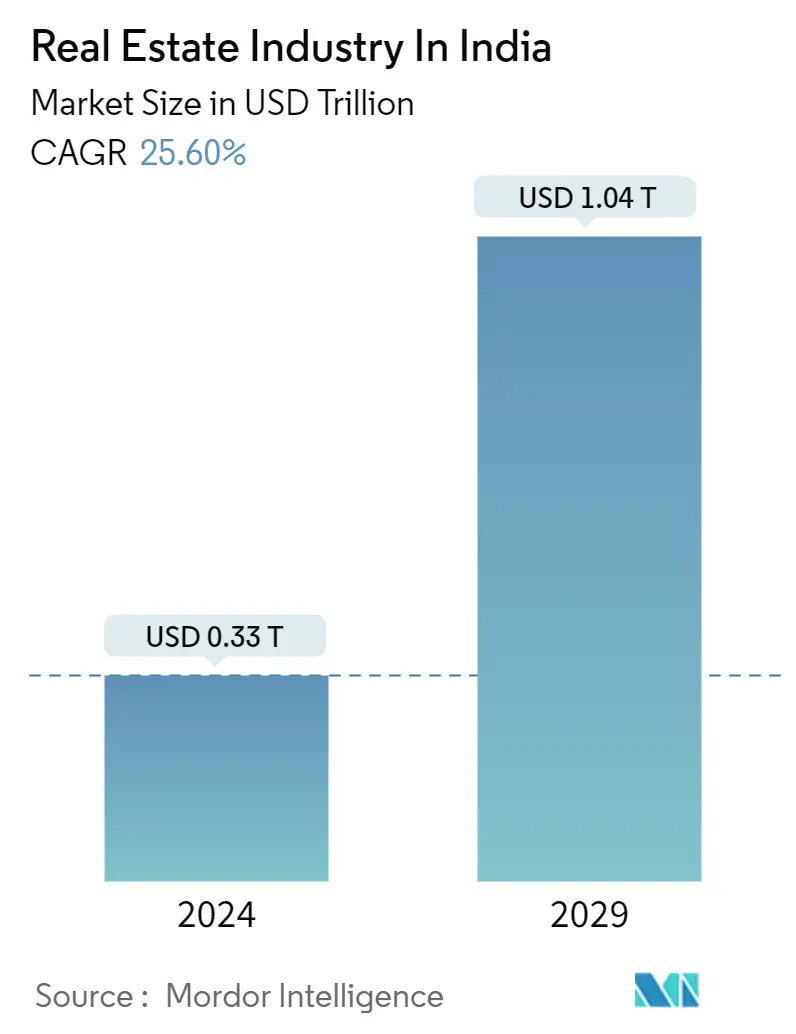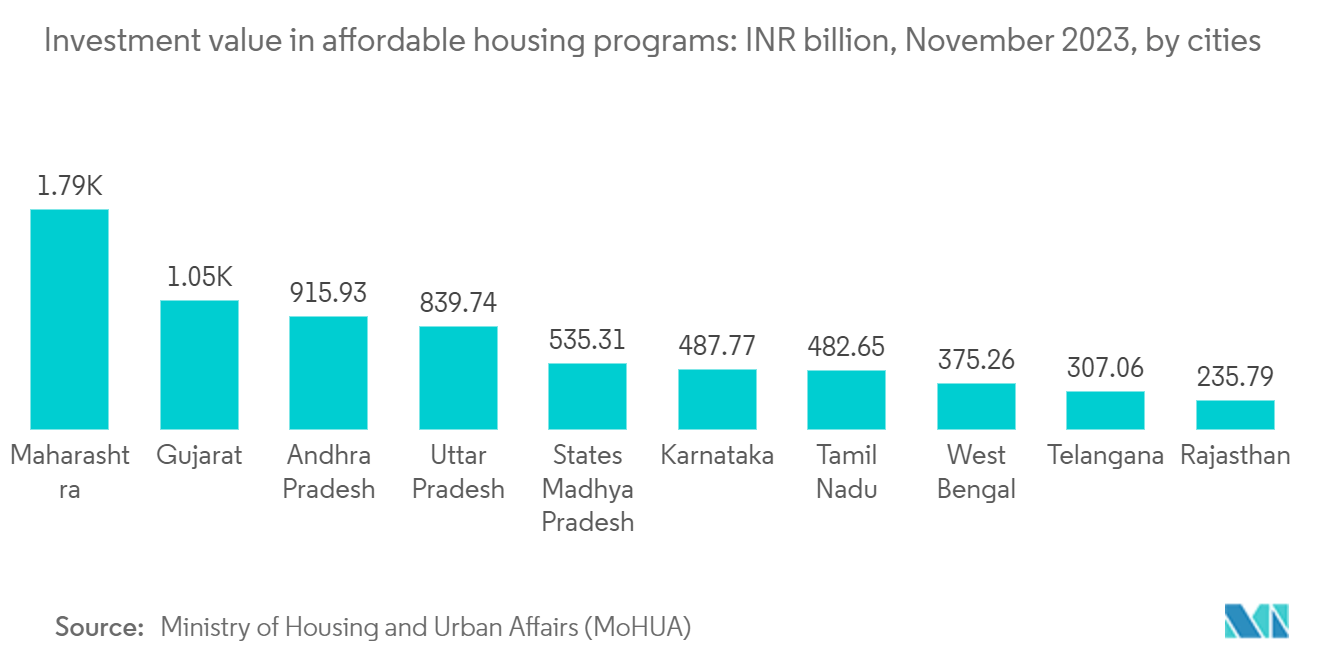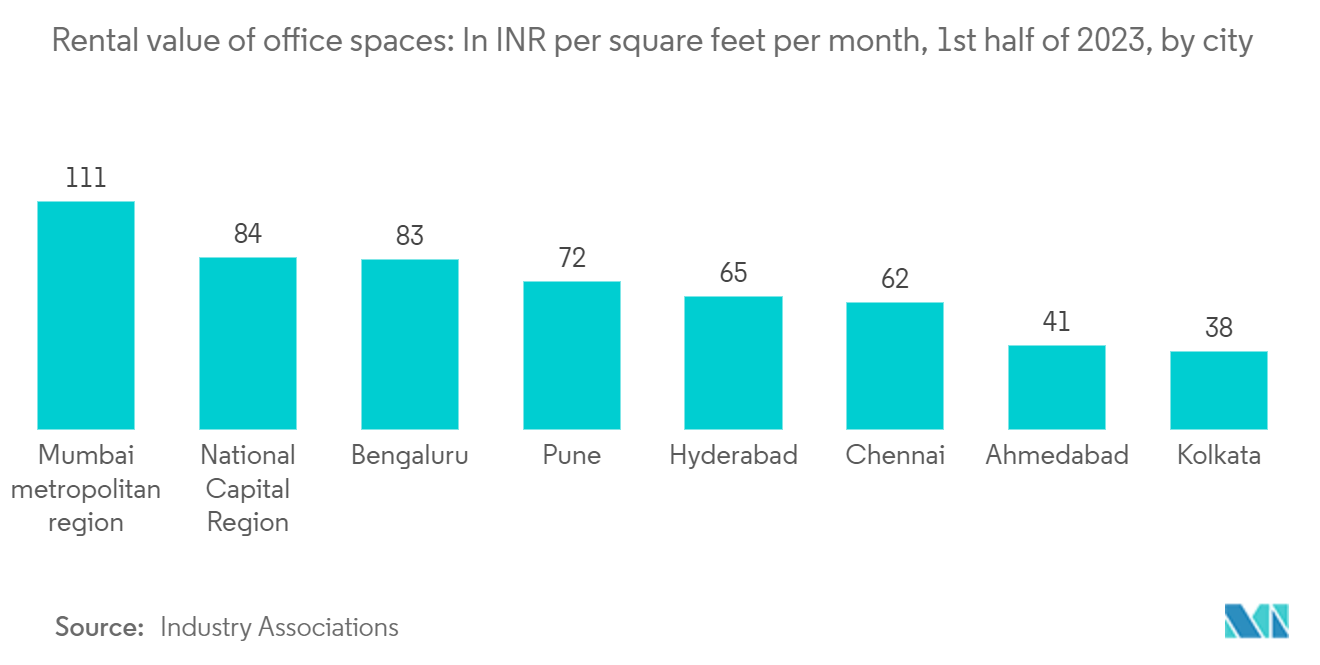Indian Real Estate Market Size

| Study Period | 2020 - 2029 |
| Base Year For Estimation | 2023 |
| Market Size (2024) | USD 0.33 Trillion |
| Market Size (2029) | USD 1.04 Trillion |
| CAGR (2024 - 2029) | 25.60 % |
| Market Concentration | Low |
Major Players
*Disclaimer: Major Players sorted in no particular order |
India Real Estate Market Analysis
The Real Estate Industry In India Market size is estimated at USD 0.33 trillion in 2024, and is expected to reach USD 1.04 trillion by 2029, growing at a CAGR of 25.60% during the forecast period (2024-2029).
- India's real estate market was affected by the COVID-19 pandemic. The residential sector was the worst hit as strict lockdown measures across major cities impacted housing sales as home registrations were suspended and home loan disbursement was slow. However, the sector recovered due to an increase in house sales, new project launches, and increasing demand for new office and commercial spaces, etc.
- The growth of this sector is well complemented by the growth in the corporate environment and the demand for office space as well as urban and semi-urban accommodation. The construction industry ranks third among the 14 major sectors in terms of direct, indirect, and induced effects in all sectors of the economy.
- In India, the real estate sector is the second-highest employment generator after agriculture. It is also expected that this sector will incur more non-resident Indian (NRI) investment, both in the short and long term. Bengaluru is expected to be the most favored property investment destination for NRIs, followed by Ahmedabad, Pune, Chennai, Goa, Delhi, and Dehradun. Retail, hospitality, and commercial real estate are also growing significantly, providing the much-needed infrastructure for India's growing needs.
- According to industry reports, real estate demand for data centers is expected to increase by 15-18 million sq. ft. by 2025. Demand for residential properties has surged due to increased urbanization and rising household income. India is among the top 10 price-appreciating housing markets internationally.
India Real Estate Market Trends
Increasing Demand for Affordable Housing
- The high demand for affordable housing dominates the housing market. The current shortage of housing in urban areas is estimated to be 10 million units by the India Brand Equity Foundation. An additional 25 million units of affordable housing are required by 2030 to meet the growth in the country's urban population.
- The real estate industry has benefited from the push for policy that has resulted in legislation like the Real Estate Regulatory Authority (RERA), the introduction of Real Estate Investment Trusts (REITs), and housing initiatives like PMAY (Pradhan-Mantri Awas Yojana) and SWAMIH (Special Window for Completion of Construction of Affordable and Mid-Income Housing Projects).
- In 2023, a target of 45,70,082 houses in the West Bengal state of India was allocated by the Ministry of Rural Development. Even though there is a big demand for housing in the country, residential launches have been on a comparatively high level over the past few years. In the financial year 2023-24, the total number of completed houses in urban areas of India under the Pradhan Mantri Awas Yojana (PMAY, The Prime Minister's Housing Plan) reached 1,58,37,128.
- Housing affordability in India was 3.3 in the financial year 2023, as compared to 3.2 in 2022, according to industry experts. As reported by the Reserve Bank of India, in the financial year 2022, banks in India advanced around INR 2 trillion (USD 24.44 billion) in housing loans, almost reaching pre-COVID levels. This reflected renewed homebuyer sentiment, as an increasing number of Indians have been investing in buying residential property, which continues to this day.

Office Real Estate Witnessing Lucrative Growth
- The Indian office real estate market has driven the growth of the commercial real estate sector in the past decades. Once dominated by information technology, office spaces are being increasingly leased by other sectors such as BFSI (banking, financial services, and insurance), engineering, manufacturing, e-commerce, and co-working sectors. The sector has demonstrated consistently low vacancy and high absorption rates.
- The Indian city of Bengaluru was estimated to have the highest net absorption among grade-A office spaces in the Asia-Pacific region. In the first quarter of 2022, the central business district (CBD) was the most expensive area for renting office space in Bengaluru, with a rental rate of INR 144 (USD 1.76) per square foot per month, according to industry experts.
- Commercial real estate investments have increased as a result of the Real Estate Regulation & Development Act (RERA) and Real Estate Investment Trusts (REITs). REIT owns, manages, and funds income-producing real estate. Office properties have emerged as the most popular sector for investment among high-net-worth individuals (HNI) in India and international PE investors, who together represent the majority of all equity investments in Indian real estate. Investors of all stripes are drawn to this industry by the high rental rates and better profits. Smaller homes and larger families contributed to the country's increase in flex and co-working spaces.
- According to industry experts in the first quarter of 2022, the Bandra-Kurla complex was the most expensive area for renting office space in the Indian city of Mumbai, with a rental rate of around INR 276 (USD 3.36) per square foot per month. Navi Mumbai offered office space at the lowest rate of around INR 67 (USD 0.82) per square foot per month among all sub-markets of Mumbai. The average rent for Mumbai office market space was around INR 138(USD 1.68) per square foot per month.

India Real Estate Industry Overview
India's real estate market is highly fragmented, with multiple players operating in the market. Higher competition among market players is impacting selling prices and land prices, further leading to oversupply in the market. Furthermore, the market is dominated by a few pan-India branded players and multiple local players. Some of the major developers in the country are Prestige Estates Projects, DLF, Prestige Group, Lodha Group, Oberoi Realty, etc.
India Real Estate Market Leaders
-
Godrej Properties
-
Prestige Estates Projects Ltd.
-
OBEROI REALTY LIMITED.
-
DLF
-
SOBHA limited
*Disclaimer: Major Players sorted in no particular order

India Real Estate Market News
- March 2024: Mahindra Lifespaces, the real estate and infrastructure development arm of the Mahindra Group, completed the acquisition of a 9.4-acre land parcel in Whitefield, Bengaluru. The land, with a potential floor space index (FSI) of approximately 1.2 million sq ft, is estimated to have a Gross Development Value (GDV) of INR 1700 crore (USD 20.39 million). The development primarily focuses on mid-premium residential apartments. Mahindra Lifespaces plans to kickstart the project's inaugural phase within a year.
- February 2024: Dholera Smart City, an ambitious greenfield project in Gujarat, India, is on a mission to establish an economically vibrant and eco-friendly urban hub. As of now, about 30% of the Phase 1 infrastructure is already in place, and prospective buyers can now invest in residential plots and villas. The authorities are eyeing a completion timeline of 2024-2025 for Phase 1, with subsequent phases slated for future expansion.
Indian Real Estate Market Report - Table of Contents
1. INTRODUCTION
- 1.1 Study Assumptions
- 1.2 Scope of the Study
2. RESEARCH METHODOLOGY
3. EXECUTIVE SUMMARY
4. MARKET INSIGHTS
- 4.1 Current Market Scenario
- 4.2 Government Regulations and Initiatives
- 4.3 Insights into Size of Real Estate Lending and Loan to Value Trends
- 4.4 Insights into Rental Yields in Residential Real Estate Segment
- 4.5 Insights into Technological Trends in the Market
- 4.6 Insights into Interest Rate Regime for General Economy and Real Estate Lending
- 4.7 Insights into Capital Market Penetration and REIT Presence in Residential Real Estate
- 4.8 Insights into Real Estate Tech and Startups Active in the Real Estate Segment (Broking, Social Media, Facility Management, and Property Management)
- 4.9 Insights into Affordable Housing Support Provided by Government and Public-private Partnerships
- 4.10 Supply Chain/Value Chain Analysis
- 4.11 Impact of COVID-19 on the Market
5. MARKET DYNAMICS
-
5.1 Market Drivers
- 5.1.1 Government Initiatives are Driving the Market
- 5.1.2 Demand for Luxury Apartments is Rising
-
5.2 Market Restraints
- 5.2.1 High-interest Rates
-
5.3 Market Opportunities
- 5.3.1 Shift Toward Sustainability
-
5.4 Porter's Five Forces Analysis
- 5.4.1 Bargaining Power of Buyers/Consumers
- 5.4.2 Bargaining Power of Suppliers
- 5.4.3 Threat of New Entrants
- 5.4.4 Threat of Substitute Products
- 5.4.5 Intensity of Competitive Rivalry
6. MARKET SEGMENTATION
-
6.1 By Property Type
- 6.1.1 Residential
- 6.1.2 Office
- 6.1.3 Retail
- 6.1.4 Hospitality
- 6.1.5 Industrial
-
6.2 By Key States
- 6.2.1 Mumbai
- 6.2.2 Delhi
- 6.2.3 Pune
- 6.2.4 Chennai
- 6.2.5 Hyderabad
- 6.2.6 Bengaluru
7. COMPETITIVE LANDSCAPE
- 7.1 Overview (Market Concentration and Major Players)
-
7.2 Company Profiles
- 7.2.1 Godrej Properties
- 7.2.2 Prestige Estates Projects Ltd
- 7.2.3 Oberoi Realty Limited
- 7.2.4 DLF
- 7.2.5 SOBHA Limited
- 7.2.6 Lodha Group
- 7.2.7 Jaypee Infratech Ltd
- 7.2.8 PNC Infratech Limited
- 7.2.9 Merlin Group
- 7.2.10 Sunteck Realty
- 7.2.11 Brigade Enterprises Ltd
- 7.2.12 Experion Developers Private Limited*
- *List Not Exhaustive
- 7.3 Other Companies
8. MAJOR ONGOING AND UPCOMING INFRASTRUCTURE PROJECTS
9. FUTURE OF THE INDIA REAL ESTATE MARKET
10. APPENDIX
** Subject To AvailablityIndia Real Estate Industry Segmentation
The real estate sector includes various phases of property dealings, including developing, selling, buying, leasing, and management processes in the industrial sector, residential sector, etc.
The report provides a comprehensive background analysis of the market, covering the current market trends, restraints, technological updates, and detailed information on various segments and the competitive landscape of the industry. Additionally, the COVID-19 impact has been incorporated and considered during the study.
The real estate industry in India is segmented by property type (residential, office, retail, hospitality, and industrial) and cities (Mumbai, Delhi, Pune, Chennai, Hyderabad, and Bangalore). The report offers market size and forecasts for all the above segments in value (USD).
| By Property Type | Residential |
| Office | |
| Retail | |
| Hospitality | |
| Industrial | |
| By Key States | Mumbai |
| Delhi | |
| Pune | |
| Chennai | |
| Hyderabad | |
| Bengaluru |
Indian Real Estate Market Research FAQs
How big is the Real Estate Industry In India Market?
The Real Estate Industry In India Market size is expected to reach USD 0.33 trillion in 2024 and grow at a CAGR of 25.60% to reach USD 1.04 trillion by 2029.
What is the current Real Estate Industry In India Market size?
In 2024, the Real Estate Industry In India Market size is expected to reach USD 0.33 trillion.
Who are the key players in Real Estate Industry In India Market?
Godrej Properties, Prestige Estates Projects Ltd., OBEROI REALTY LIMITED., DLF and SOBHA limited are the major companies operating in the Real Estate Industry In India Market.
What years does this Real Estate Industry In India Market cover, and what was the market size in 2023?
In 2023, the Real Estate Industry In India Market size was estimated at USD 0.25 trillion. The report covers the Real Estate Industry In India Market historical market size for years: 2020, 2021, 2022 and 2023. The report also forecasts the Real Estate Industry In India Market size for years: 2024, 2025, 2026, 2027, 2028 and 2029.
What are the major Opportunities in the Real Estate Market in India?
The major Opportunities in the Real Estate Market in India are a) Development of smart cities and sustainable projects b) Rising demand for warehousing facilities c) Growth of online real estate platforms
Real Estate in India Industry Report
The Indian real estate market is projected to experience robust growth driven by factors like rapid urbanization, increasing disposable incomes, and rising demand for residential and commercial properties. The real estate industry in India is Segmented by property type, including residential, commercial, industrial, and land, the market is further divided into sales and rental operations, operating through both online and offline modes to cater to diverse consumer preferences and enhance accessibility. Regional segmentation illustrates varied growth dynamics across different areas, emphasizing localized market conditions and opportunities. Key government initiatives, such as investments in smart city projects and tax exemptions, alongside environmental and regulatory concerns, shape sustainable practices within the sector. The burgeoning population fuels the demand for infrastructure, significantly impacting the real estate market size in India and driving the trend towards smart, sustainable projects. The competitive landscape remains dynamic, with continuous innovation aimed at meeting evolving market needs. For detailed statistics on the Real Estate in India market share, size, and revenue growth rate, along with a market forecast outlook and historical overview, refer to Mordor Intelligence™ Industry Reports, where you can download a free report PDF sample.



